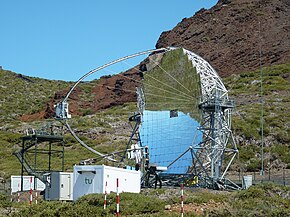MAGIC (Major Atmospheric Gamma Imaging Cherenkov Telescopes, later renamed to MAGIC Florian Goebel Telescopes) is a system of two Imaging Atmospheric Cherenkov telescopes situated at the Roque de los Muchachos Observatory on La Palma, one of the Canary Islands, at about 2200 m above sea level. MAGIC detects particle showers released by gamma rays, using the Cherenkov radiation, i.e., faint light radiated by the charged particles in the showers. With a diameter of 17 meters for the reflecting surface, it was the largest in the world before the construction of H.E.S.S. II.
 The second MAGIC telescope | |
| Alternative names | MAGIC |
|---|---|
| Part of | Roque de los Muchachos Observatory |
| Location(s) | La Palma, Atlantic Ocean, international waters |
| Coordinates | 28°45′43″N 17°53′24″W / 28.761944444444°N 17.89°W |
| Altitude | 2,200 m (7,200 ft) |
| Wavelength | Gamma rays (indirectly) |
| Built | 2004 |
| First light | 2004, 2009 |
| Telescope style | IACT reflecting telescope gamma-ray telescope |
| Diameter | 17 m (55 ft 9 in) |
| Collecting area | 236 m2 (2,540 sq ft) |
| Focal length | f/D 1.03 |
| Mounting | metal structure |
| Replaced | HEGRA |
| Website | magic |
| | |
The first telescope was built in 2004 and operated for five years in standalone mode. A second MAGIC telescope (MAGIC-II), at a distance of 85 m from the first one, started taking data in July 2009. Together they integrate the MAGIC telescope stereoscopic system.[1]
MAGIC is sensitive to cosmic gamma rays with photon energies between 50 GeV (later lowered to 25 GeV) and 30 TeV due to its large mirror; other ground-based gamma-ray telescopes typically observe gamma energies above 200–300 GeV. Gamma-ray astronomy also utilizes satellite-based detectors, which can detect gamma-rays in the energy range from keV up to several GeV.
Aims
editThe goals of the telescope are to detect and study primarily photons coming from:
- Accretion of black holes in active galactic nuclei
- Supernova remnants, due to their interest as sources of cosmic rays.
- Other galactic sources such as pulsar wind nebulae or X-ray binaries.[2][3]
- Unidentified EGRET or Fermi sources
- Gamma ray bursts
- Annihilation of dark matter
Observations
editMAGIC has found pulsed gamma-rays at energies higher than 25 GeV coming from the Crab Pulsar.[4] The presence of such high energies indicates that the gamma-ray source is far out in the pulsar's magnetosphere, in contradiction with many models.
In 2006 MAGIC detected[5] very high energy cosmic rays from the quasar 3C 279, which is 5 billion light years from Earth. This doubles the previous record distance from which very high energy cosmic rays have been detected. The signal indicated that the universe is more transparent than previously thought based on data from optical and infrared telescopes.
MAGIC did not observe cosmic rays resulting from dark matter decays in the dwarf galaxy Draco.[6] This strengthens the known constraints on dark matter models.
A much more controversial observation is an energy dependence in the speed of light of cosmic rays coming from a short burst of the blazar Markarian 501 on July 9, 2005. Photons with energies between 1.2 and 10 TeV arrived 4 minutes after those in a band between 0.25 and 0.6 TeV. The average delay was 30 ±12 ms per GeV of energy of the photon. If the relation between the space velocity of a photon and its energy is linear, then this translates into the fractional difference in the speed of light being equal to minus the photon's energy divided by 2×1017 GeV. The researchers have suggested that the delay could be explained by the presence of quantum foam, the irregular structure of which might slow down photons by minuscule amounts only detectable at cosmic distances such as in the case of the blazar.[7][8]
Technical specifications
editEach telescope has the following specifications:
- A collecting area 236 m2 consisting of 956 50 cm × 50 cm aluminium individual reflectors
- A lightweight carbon fibre frame
- A detector consisting of 396 separate hexagonal photomultiplier detectors in the center (diameter: 2.54 cm) surrounded by 180 larger photomultiplier detectors (diameter: 3.81 cm).
- Data are transferred in analogue form by fibre optic cables
- Signal digitization is done via an ADC (analog-to-digital converter) with a 2 GHz sampling rate
- Total weight of 40,000 kg
- Reaction time to move to any position of the sky less than 22 seconds[9]
Each mirror of the reflector is a sandwich of an aluminum honeycomb, 5 mm plate of AlMgSi alloy, covered with a thin layer of quartz to protect the mirror surface from aging. The mirrors have spherical shape with a curvature corresponding to the position of the plate in the paraboloid reflector. The reflectivity of the mirrors is around 90%. The focal spot has a size of roughly half a pixel size (<0.05°).
Directing the telescope to different elevation angles causes the reflector to deviate from its ideal shape due to the gravity. To counteract this deformation, the telescope is equipped with an Active Mirror Control system. Four mirrors are mounted on each panel, which is equipped with actuators that can adjust its orientation in the frame.
The signal from the detector is transmitted over 162 m of optical fibers. The signal is digitized and stored in a 32 kB ring buffer. The readout of the ring buffer results in a dead time of 20 μs, which corresponds to about 2% dead time at the design trigger rate of 1 kHz. The readout is controlled by an FPGA (Xilinx) chip on a PCI (MicroEnable) card. The data is saved to a RAID0 disk system at a rate up to 20 MB/s, which results in up to 800 GB raw data per night.[9]
Collaborating institutions
editPhysicists from over twenty institutions in Germany, Spain, Italy, Switzerland, Croatia, Finland, Poland, India, Bulgaria and Armenia collaborate in using MAGIC; the largest groups are at
- Institut de Física d'Altes Energies (IFAE), Spain
- Universitat Autònoma de Barcelona, Spain
- Universidad Complutense de Madrid, Spain
- Centro de Investigaciones Energéticas, MedioAmbientales y Tecnológicas (CIEMAT), Spain
- Instituto de Astrofísica de Andalucía, Spain
- Instituto de Astrofísica de Canarias, Spain
- ETHZ, Zürich, Switzerland
- UNIGE, Geneva, Switzerland
- Dipartimento di Fisica and INFN, University of Padua, Italy
- Tuorla Observatory, Piikkiö, Finland
- Dipartimento di Fisica and INFN, University of Siena, Italy
- Dipartimento di Fisica and INFN, University of Udine, Italy
- TU Dortmund University, Germany
- University of Würzburg, Germany
- Max Planck Institute for Physics, Germany
- Institute for Particle Physics, Zürich, Switzerland
- National Institute for Astrophysics (INAF), Italy
- Institute for Nuclear Research and Nuclear Energy, Sofia, Bulgaria
- Croatian MAGIC Consortium (Institute Ruđer Bošković, Zagreb; University of Split, Split; University of Rijeka, Rijeka), Croatia
See also
editReferences
edit- ^ "Technical status of the MAGIC telescopes", MAGIC collaboration, Proc. International Cosmic Rays Conference 2009, arXiv:0907.1211
- ^ Albert, J. (2006). "Variable Very-High-Energy Gamma-Ray Emission from the Microquasar LS I +61 303". Science. 312 (5781): 1771–3. arXiv:astro-ph/0605549. Bibcode:2006Sci...312.1771A. doi:10.1126/science.1128177. PMID 16709745. S2CID 20981239.
- ^ Albert, J.; Aliu, E.; Anderhub, H.; Antoranz, P.; Armada, A.; Baixeras, C.; Barrio, J. A.; Bartko, H.; Bastieri, D.; Becker, J. K.; Bednarek, W.; Berger, K.; Bigongiari, C.; Biland, A.; Bock, R. K.; Bordas, P.; Bosch-Ramon, V.; Bretz, T.; Britvitch, I.; Camara, M.; Carmona, E.; Chilingarian, A.; Coarasa, J. A.; Commichau, S.; Contreras, J. L.; Cortina, J.; Costado, M. T.; Curtef, V.; Danielyan, V.; et al. (2007). "Very High Energy Gamma-Ray Radiation from the Stellar Mass Black Hole Binary Cygnus X-1" (PDF). The Astrophysical Journal. 665 (1): L51 – L54. arXiv:0706.1505. Bibcode:2007ApJ...665L..51A. doi:10.1086/521145. hdl:2445/150806. S2CID 15302221.
- ^ Aliu, E.; Anderhub, H.; Antonelli, L. A.; Antoranz, P.; Backes, M.; Baixeras, C.; Barrio, J. A.; Bartko, H.; Bastieri, D.; Becker, J. K.; Bednarek, W.; Berger, K.; Bernardini, E.; Bigongiari, C.; Biland, A.; Bock, R. K.; Bonnoli, G.; Bordas, P.; Bosch-Ramon, V.; Bretz, T.; Britvitch, I.; Camara, M.; Carmona, E.; Chilingarian, A.; Commichau, S.; Contreras, J. L.; Cortina, J.; Costado, M. T.; Covino, S.; et al. (2008). "Observation of Pulsed -Rays Above 25 GeV from the Crab Pulsar with MAGIC". Science. 322 (5905): 1221–1224. arXiv:0809.2998. Bibcode:2008Sci...322.1221A. doi:10.1126/science.1164718. PMID 18927358. S2CID 5387958.
- ^ Albert, J.; Aliu, E.; Anderhub, H.; Antonelli, L. A.; Antoranz, P.; Backes, M.; Baixeras, C.; Barrio, J. A.; Bartko, H.; Bastieri, D.; Becker, J. K.; Bednarek, W.; Berger, K.; Bernardini, E.; Bigongiari, C.; Biland, A.; Bock, R. K.; Bonnoli, G.; Bordas, P.; Bosch-Ramon, V.; Bretz, T.; Britvitch, I.; Camara, M.; Carmona, E.; Chilingarian, A.; Commichau, S.; Contreras, J. L.; Cortina, J.; Costado, M. T.; et al. (2008-06-27). "Very-High-Energy Gamma Rays from a Distant Quasar: How Transparent is the Universe?". Science. 320 (5884): 1752–4. arXiv:0807.2822. Bibcode:2008Sci...320.1752M. doi:10.1126/science.1157087. PMID 18583607. S2CID 16886668.
{{cite journal}}: CS1 maint: date and year (link) - ^ Albert, J.; et al. (2008). "Upper Limit for γ‐Ray Emission above 140 GeV from the Dwarf Spheroidal Galaxy Draco". The Astrophysical Journal. 679 (1): 428–431. arXiv:0711.2574. Bibcode:2008ApJ...679..428A. doi:10.1086/529135. S2CID 15324383.
- ^ Albert, J.; Ellis, John; Mavromatos, N. E.; Nanopoulos, D. V.; Sakharov, A. S.; Sarkisyan, E. K. G. (2008). "Probing quantum gravity using photons from a flare of the active galactic nucleus Markarian 501 observed by the MAGIC telescope". Physics Letters B. 668 (4): 253–257. arXiv:0708.2889. Bibcode:2008PhLB..668..253M. doi:10.1016/j.physletb.2008.08.053. S2CID 5103618.
- ^ Lee, Chris (2007-08-23). "Probing quantum gravity with gamma ray bursters". Ars Technica. Retrieved 2022-08-10.
- ^ a b Cortina, J.; for the MAGIC collaboration (2005). "Status and First Results of the MAGIC Telescope". Astrophysics and Space Science. 297 (2005): 245–255. arXiv:astro-ph/0407475. Bibcode:2005Ap&SS.297..245C. doi:10.1007/s10509-005-7627-5. S2CID 16311614.
